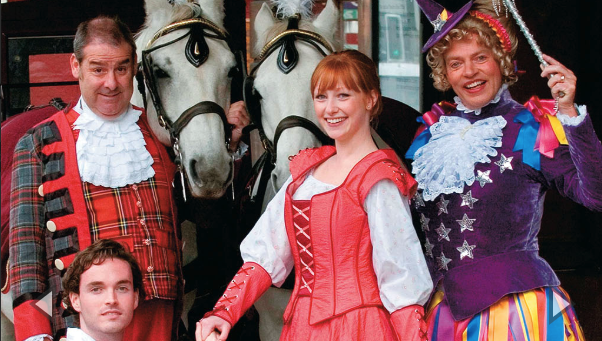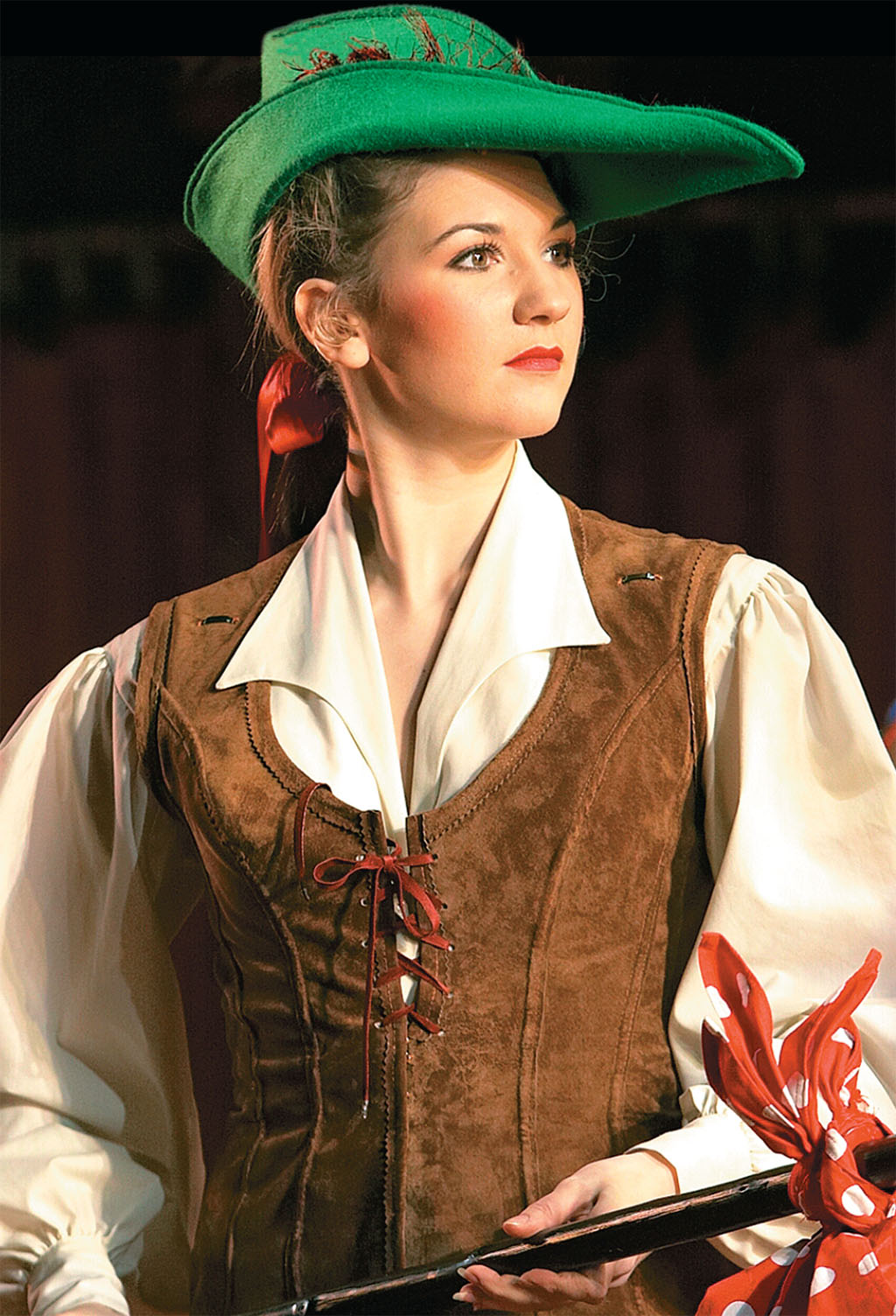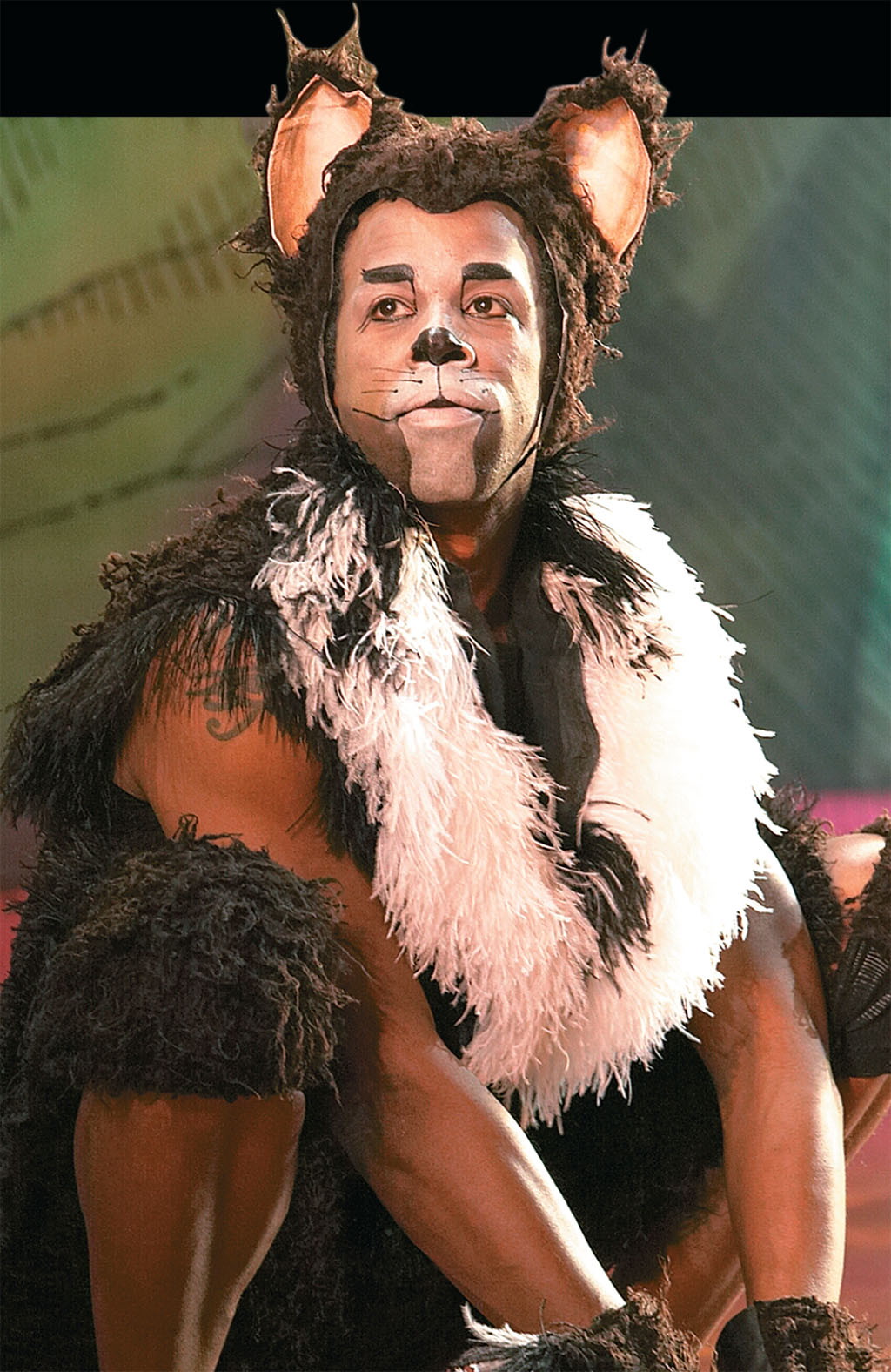
Cinderella and Prince Charming are joined by Fairy May and Baron Hard Up outside Edinburgh’s King’s Theatre, celebrating last year’s production of the pantomime classic. Like all great pantos, the tale is badly fractured
It's a fractured fairytale full of knockabout, cross-dressing, audience participation, and gags as old as Methuselah. It's the inimitable panto!
Editor's note: Originally published in July 2016.
Around Christmas and well in to January, theaters throughout Britain resound to choruses of “He’s behind you!” and “Oh, no he’s not!” It’s pantomime season once more. Stages sprout giant beanstalks and Snow White dozes while the seven dwarfs “hi ho, hi ho” to work.
Cinderella skips off to the ball in her glass slippers, and Dick Whittington rides again. There’s a shapely, thigh-slapping girl acting Principal Boy, a middle-aged man camps it up as the Dame and a couple of hot-and-bothered bit players squeeze into a cow costume for the sticky duration. While outrageous plots, slapstick routines and double entendre jokes make audiences laugh and groan in equal measure, theater managers count the profits from the one guaranteed money-spinner of the year.
If you haven’t been raised on British “panto,” it must baffle. Its madcap mix of fairytale and exotic scenery, silly songs, topical humor and satire defies logic. One panto historian, A.E. Wilson, hit the nail on the head when he called it “a truce to reason, a holiday to common sense.” But make no mistake: There are plenty of rules and conventions to be obeyed. And the audience—as much an indispensable part of the cast as the actors, always ready to bellow in the right places—knows what they are. Mess with them at your peril!
Britain’s yuletide pleasure, like some multicolored patchwork quilt, has been pieced together from elements of many traditions: commedia dell’arte, extravaganza, burlesque, Victorian music hall, legend, fairytale, history. The secret of its longevity is that it has appropriated the popular and moved with the times, while at heart somehow remaining the same.
The first recorded use of the word “pantomime” to publicize an English entertainment was in March 1717, when a London newspaper proclaimed “a play call’d The Maid’s Tragedy” combined with “a new dramatic entertainment of dancing, after the manner of the ancient panto-mimes, call’d The Loves of Mars and Venus.” It was created by John Weaver, dancing master at the Theatre Royal, Drury Lane. Weaver (1673-1760) was motivated by a desire to raise the profile of dancing in England, which he considered a neglected art deserving of more serious respect. He meant “pantomime” in the classic Greek or Roman sense—the pantomimus was a masked dancer/performer and “imitator of all things.”
Paradoxically, his silently gesturing dancers have been all but forgotten and instead, he bequeathed the name to a British theatrical convention that in all likelihood would have appalled him.
The form and style of early British pantomime had its roots in the populist Italian commedia dell’arte of the 16th and 17th centuries, which crossed the Channel to England via France. From the commedia came its stock plots and characters, improvised knockabout fun, music and dance: tales of young lovers thwarted by their elders, with plenty of excuses for acrobatics and buffoonery before a happy dénouement. Enter amorous Harlequin and Columbine, variations on the old miser Pantalone and his friend Il Dottore, the braggart soldier Il Capitano, and servants both quick-witted (Scaramuccia) and dim (Pulcinella).
If Weaver gave us the pantomime name, then John Rich, “Prince of Harlequins,” helped to make comedic “Harlequinades” a runaway success. Rich (1692-1761) was an actor-manager of London’s Lincoln’s Inn Fields Theatre (now vanished) and later the Theatre Royal in Covent Garden. Ill-educated and forgetful, he was nevertheless a talented mimic dancer and appeared under the stage name Lun. In the mute role of Harlequin, now a witty hero and with the ability to perform magic, he found his ideal role.
Rich’s The Magician; or, Harlequin a Director of March 1721 is highlighted by Gerald Frow in his book Oh, Yes It Is! as the first real English pantomime. It followed a performance of King Lear and is described as a mix of serious scenes from Ovid “or some other fabulous writer” interwoven with comic interludes in which Harlequin courted Columbine. Mind-boggling transformations of people into wheelbarrows and trees into houses illustrated Rich’s grasp of stage spectacle. The entertainment’s title was topical—the South Sea Bubble had just burst and “directors” of anything were mistrusted.

Summer Strallen played Dick Whittington in 2006’s boffo production at the Barbican. MAUEL HARLAN/BARBICAN THEATRE
Certainly, many of the ingredients of a panto as we know it were here. But it was a good while before “the silly” split off from “the serious” to be staged as a stand-alone that incorporated full speaking parts, was aimed primarily at children and shown specifically at Christmas. In the meantime, the entertainment remained part of a mixed bill, with, typically, a short introduction on a serious theme, a popular tale/myth and—what the audience really loved—the visually exciting transformation of the actors into their funny harlequin/commedia roles.
Another icon of the early tradition was Joseph Grimaldi (1779-1837). The London-born son of an Italian ballet master-cumpantomimist and a Cockney chorus dancer, “Joey” became the quintessential Clown. Like Harlequin, Clown emerged from the commedia dell’arte and tripped—usually literally—the panto boards until, by the 1930s, the Harlequinade finally faded away.
Grimaldi’s biographer, one Charles Dickens, wrote, “There he stands, the cunning, round-faced rascal, knock-kneed, yet as agile as if he had not a bone in his body.” When King George IV saw Grimaldi-Clown’s antics at Covent Garden, he roared so much he burst the royal stays.
In the years after Grimaldi’s death, Harlequinades shape-shifted further, influenced particularly by the bawdy, crowd-pleasing world of Victorian music hall with its catchy, subversive sing-alongs. Before you could intone, “Whenever I sees a copper, I always tells a whopper,” or some other witty music hall ditty, modern panto was born.
By now pantomime writers had been dipping into the well of fairy tale and history for their plots. Jack and the Beanstalk, Aladdin, Little Red Riding Hood, Cinderella, Dick Whittington, The Sleeping Beauty and Puss in Boots were all pantomimed in the latter half of the 18th and the first half of the 19th centuries and remain firm favorites today. Peter Pan by J.M. Barrie is something of an exception, hitting the stage as “recently” as 1904. Just as the boy would not grow up, so the audiences never tire and it’s a top seller. Moreover, every performance of the play (and sale of the novel that preceded it) benefits Great Ormond Street Children’s Hospital in London, to whom Barrie gave the rights.
The Victorian years also marked a reaction against the violence of “comic business” in Harlequinades and pantomimes. Until then, boiling babies or running them out flat through a mangle had spectators guffawing. Of course, to this day, the physicality and cruelty of some slapstick continues and raises the roof—it’s the stock in trade. But it stops short of earlier savagery.
And what of those other essentials, the woman who plays Principal Boy and the man who plays the Pantomime Dame? The “breeches” part goes back farther than most people realize. As early as 1661, after the Restoration permitted women onto the stage, Samuel Pepys records the sight of an actress dressed in men’s clothes with “the best legs that ever I saw.”
But the tradition of a young woman playing the heroic male lead is really drawn from the teasing realm of burlesque and came to the fore in the not-so-strait-laced Victorian era. In short, it was the perfect excuse for a good old gawp at a well-turned ankle and leg in limb-hugging attire—the young lady obliged with lots of hearty thigh slapping, lest you failed to notice. For a while from the 1950s—sacrilege—the custom waned; comic film star Norman Wisdom famously stepped out as Aladdin in 1957. But the likes of lissom singer Cilla Black reclaimed the role for the ladies in the 1970s. Today, you’re not guaranteed the Principal Boy is a girl, but most Dads hope “he” is.
Then, there’s nothing like a Pantomime Dame. Or rather, “oh, yes there is”: Men have played old women since the earliest times, certainly in the medieval Mystery Plays when, for example, Mrs. Noah was performed by a man. After the Restoration—and even now—maybe aging actresses have preferred to eschew the part. No worries, many a man has willingly donned dresses and tresses and slapped on excessive rouge, in order to flounce with full comedic effect as an Ugly Sister in Cinderella or Widow Twankey in Aladdin.
3
Derek Elroy plays the skin—Dick Whittington’s faithful furry feline, Tommy the Cat. MANUEL HARLAN/BARBICAN THEATRE
Nor must we forget the “skin” parts: the Goose in Mother Goose, the cat in Puss in Boots or Dick Whittington, Daisy the Cow in Jack and the Beanstalk. Flicking back through the annals, it’s extraordinary what actors have endured for their art. A 3-year-old Grimaldi was almost killed when playing a monkey—the chain on which he was being swung snapped and he flew into the arms of a spectator. The most creative “skin” player, actor and acrobat George Conquest, studied animals at the zoo or aquarium before bringing them to life on the 19th-century stage: an octopus whose tentacles stretched 28 feet tip to tip, a porcupine made of more than 2,500 parts that moved as Conquest twiddled his quills. He made his costumes himself and he leapt across the scene using as many as 29 stage traps. Machinists and set designers had a ball with pantomime.
Tales today of the challenges of the skin part are legion: one actor, Michael Simkins, recalls having once lost nearly 14 pounds in six weeks as he sweated in the cheap nylon fur costume of the Cowardly Lion at Worthing Theatre, West Sussex. As most of his exertions collected in the feet of the costume, he believes he became the first suspected case of trench foot in southern England since World War I. Playing the animal is a rite of passage for many a thespian, as is the prospect of facing a bellowing matinee audience of kids before you’ve fully recovered from the previous night’s performance. Exhilarating fun for performers and audience alike, panto has never been for the fainthearted.
With a wave of a magic wand, that brings us to the audience. This, too, has changed over the centuries. At first it was mainly adult; only later did panto metamorphose into a specifically “children’s show,” though it retains plenty of gags for grown-ups. Topicality has always been its lifeblood and the insertion of allusions to matters of national or local interest has kept the public coming back for more. South Sea Bubble jibes in The Magician; or, Harlequin a Director have already been mentioned. In Bang Up! or, Harlequin Prime (1810), the latest fads of the aristocracy were the targets of satire: “bang up” meant at the forefront of fashion and “prime” meant first rate. Following experiments by Count Zeppelin, airships were landing in several shows in the early 1900s, including one in Jack and the Beanstalk at Birmingham that offered transport to Cloudland. In the later 20th century, someone was more likely to exclaim, “Beam me up, Scotty!” The more risqué gossip and quips for the grown-ups simply float over children’s heads.
Participation and dialogue between audience and stage is paramount. You find it in the time-honored, ad nauseam chants of “He’s behind you!” (“Oh, no he’s not!”—“Oh, yes he is!”) as a character bumbles about looking for his pursuer. You also find it in the all-together-now singing of songs, from old music hall staples like “ta-ra-ra-boom-de-ay” to a wry take on a current pop song, with join-in chorus suitably adulterated to fit the show. There are tongue twisters and puns and, it can’t be avoided any longer: cringe-making jokes. A national newspaper last year listed the 10 best old panto gags, including: “What did Cinderella say when the chemist lost her photographs? Some day my prints will come.” Boom, boom. At this point, the actor is likely to turn conspiratorially to the auditorium and admit, “That’s as good as the jokes get tonight.” The collusion is complete.
For actors, pantos, like end-of-pier summer shows, offer bread and butter work. Indeed, there’s a certain cachet about appearing in panto, and crowd-pulling celebrities are often cast in the starring roles, just like their music hall counterparts before them. If they break off from the main action of Aladdin or Mother Goose to work in a plug for their latest song, TV program or book, so be it. They’re just following the self-publicizing antics of the Victorian songsters. And, anyway, incongruous interludes are expected.
Pantomime has always had its nay-sayers and critics, been decried as low-brow or simply too silly. Last season the National Operatic and Dramatic Association suggested the genre needed to be dragged into the 21st century with new plots and jokes, adding that some titles such as Snow White and the Seven Dwarfs were no longer apt in an age of political correctness. Panto never has been “PC.” And as long as it continues to evolve, parachuting popular modern elements into the tried, tested, and very much loved rituals and tales, then beanstalks will continue to flourish and we can all enjoy a holiday to common sense. Oh, yes we will!






Comments